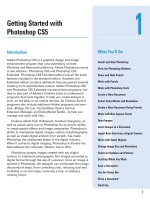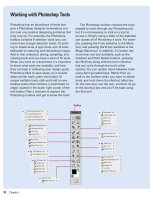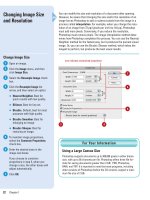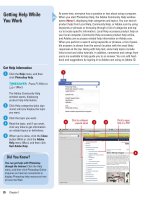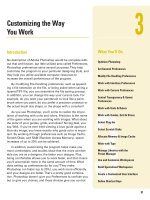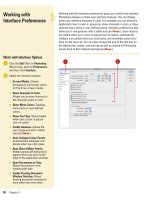Photoshop cs5 by steve Johnson part 54 doc
Bạn đang xem bản rút gọn của tài liệu. Xem và tải ngay bản đầy đủ của tài liệu tại đây (636.45 KB, 5 trang )
ptg
336 Chapter 14
The Liquify filter gives you amazing control over an image. For example,
you can distort the image pixels almost as if the image were an oil
painting that had yet to dry. In addition, you can magnify specific areas
of an image or reduce them in size. The Liquify filter lets you push, pull,
rotate, reflect, pucker, and bloat any area of an image. The distortions
you create can be subtle or drastic, which makes the Liquify command
a powerful tool for retouching images as well as for creating artistic
effects.
Modifying Images
with Liquify
Modify Images with Liquify
Open a document.
Select the Layers panel, and then
select the layer you want to liquify.
Click the Filter menu, and then
click Liquify.
Select from the following Liquify
tools:
◆ Forward Warp. Pushes pixels in
front of the brush as you drag.
◆ Reconstruct. Drag inside the
image, using a specific brush
size to restore previously
modified areas of the image.
◆ Twirl Clockwise. Click in an
area to twirl the pixels
(contained inside the brush tip)
clockwise. To twirl counter
clockwise, hold down the Alt
(Win) or Option (Mac) key.
◆ Pucker. Click and hold to move
pixels towards the center of the
brush tip.
◆ Bloat. Click and hold to move
pixels away from the center of
the brush tip.
◆ Push Left. Drag to push pixels
to the left of the brush tip. For
example, dragging straight up
pushes pixels to the left, and
dragging to the right pushes
pixels up.
4
3
2
1
Forward Warp
Twi rl Clock wise
4
From the Library of Wow! eBook
ptg
Chapter 14 Manipulating Images with Filters 337
◆ Mirror. Drag to copy pixels to
the left of the stroke.
◆ Turbulence. Smoothly
scrambles the pixels in an
image. Creates realistic waves
or fire.
◆ Freeze. Paints a mask over an
area of the image, and then
protects that area from change.
◆ Thaw. Erases the protective
mask created with the Freeze
tool.
◆ Hand. Drag to move the visible
image. Useful if the image is
larger than the physical
document window.
◆ Zoom. Click to zoom in on a
specific area of the image.
Click and drag to define an
area to zoom in on. Hold down
the Alt (Win) or Option (Mac)
key and click to zoom out.
Click OK.
5
Bloat
Mirror
Tur bulence
5
From the Library of Wow! eBook
ptg
338 Chapter 14
The Liquify Tool options control the brush tip. Since all the Liquify com-
mands are executed with a brush, it's important to understand how you
control the brush tip. When you apply the brush stroke, the faster you
drag the mouse, the less effect is applied to the image; if you drag
slowly, you gain more control and the effect is more intense. Practice
dragging the cursor over the image to produce different effects, and if
you make a mistake, don't forget the undo key—Ctrl+Z (Win), A+Z
(Mac).
Working with Liquify
Tool Options
Work with Liquify Tool Options
Open a document.
Select the Layers panel, and then
select the layer on which you want
to use the liquify tool.
Click the Filter menu, and then
click Liquify.
Select from the following Liquify
Too l op ti on s:
◆ Brush Size. Select a value (1 to
600).
◆ Brush Density. Select a value (0
to 100). Brush Density controls
how much the brush feathers at
the ends. Lower values equal
increased feathering.
◆ Brush Pressure. Select a value
(1 to 100). Determines how
quickly a liquify effect is
applied to the image when the
brush is moving. The lower the
value, the slower the effect.
◆ Brush Rate. Select a value (0 to
100). Determines how quickly a
liquify effect is applied to the
image when the brush is
stationary. The lower the value,
the slower the effect.
◆ Turbulent Jitter. Select a value
(1 to 100). Controls how tightly
the Turbulent Jitter tool distorts
the image. The higher the
value, the more distortion.
4
3
2
1
4
Liquify Tool options
From the Library of Wow! eBook
ptg
Chapter 14 Manipulating Images with Filters 339
◆ Reconstruct Mode. Determines
how the Reconstruct tool
restores the image. Click the
list arrow, and then select from
the available options:
◆ Revert
◆ Rigid
◆ Stiff
◆ Smooth
◆ Loose
◆ Reconstruct. Click the button to
reconstruct the image stage by
stage.
◆ Restore All. Click the button to
restore the image to its original
state.
◆ Stylus Pressure. Select the
check box if you're using a
drawing tablet. The pressure
you apply to the drawing tablet
will now control the pressure
applied with the Liquify brush.
Click OK.
5
5
From the Library of Wow! eBook
ptg
340 Chapter 14
When you work with an image that contains a selection or mask, you
can use that information to control how the Liquify command adjusts
the image. Think of the mask as a visual representation of the work
areas of the image. Creating a mask gives you precise control over
what portions of the image are modified.
Working with Liquify
Mask Options
Work with Liquify Mask Options
Open a document.
Select the Layers panel, and then
select the layer containing a
selection or mask.
Click the Filter menu, and then
click Liquify.
Select from the following Liquify
Mask options:
◆ Replace Selection. Shows the
selection, transparency or layer
mask in the original image.
◆ Add To Selection. Shows the
mask in the original image, so
you can then add to the
selection using the Freeze tool.
◆ Subtract From Selection.
Subtracts pixels in selection
from current protection created
with the Freeze tool.
◆ Intersect With Selection. Uses
only pixels that are selected
and currently frozen.
◆ Invert Selection. Uses your
selection to invert the currently
frozen area.
Click OK.
5
4
3
2
1
1
5
4
From the Library of Wow! eBook
